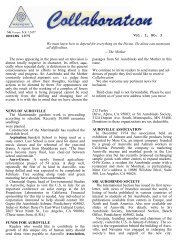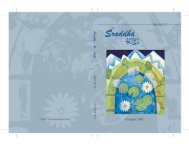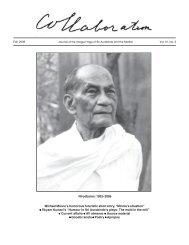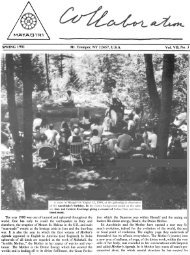1989 spring.pdf - Sri Aurobindo Ashram
1989 spring.pdf - Sri Aurobindo Ashram
1989 spring.pdf - Sri Aurobindo Ashram
You also want an ePaper? Increase the reach of your titles
YUMPU automatically turns print PDFs into web optimized ePapers that Google loves.
to deal with one’s life. I never imagined<br />
myselfreaching great spiritual height. Other<br />
people may have it, but I never had. I suppose<br />
what attracted me, more than anything<br />
else, was bliss. In other words, to feel right<br />
in life. To feel blissful or to feel a peace or<br />
to be able to do the things one has to do to get<br />
through life. But I never envisioned myself<br />
as a great realized being or envisioned that<br />
as a goal for myself. I always wanted every<br />
moment of my life and every movement that<br />
I made with my body to be the right one. To<br />
be one that felt comfortable and was in the<br />
great harmony of things. That’s what I envisioned,<br />
even as a child.<br />
C: And that has never changed when you<br />
were going through your periods of doubt<br />
E: No. Well, I went through terrible anxieties;<br />
it was more anxieties than doubts. I<br />
mean, I never doubted Mother. I may feel<br />
that I’m certainly not capable of doing Her<br />
yoga and whatever advance I make in yoga<br />
is because She pulls-pulls me along, not<br />
because of anything I do.<br />
C: But I believed, and I think most people<br />
believed, that Mother was going to supramental&<br />
her body, and we read these things<br />
in the Agenda now where She said, “He<br />
never told me whether I was going to do it or<br />
not.”<br />
E: How do you know She didn’t supramentalize<br />
it I mean, just because She left it.<br />
Even <strong>Sri</strong> <strong>Aurobindo</strong> says that supramentalization<br />
doesn’t mean that you can’t get rid of<br />
your body.<br />
C: Well, anyway...when the Mother left<br />
her body that didn’t confuse you<br />
E: No. I was sad in a kind of human way,<br />
but it had no effect at all on what I believed..<br />
. what Shesaid thepossibilities were.<br />
What the movement of evolution was going<br />
towards. That didn’t bother me at all. It<br />
never even occurred to me to regard it as a<br />
failure.<br />
C: I didn’t feel that at the time. I really<br />
enjoyed reading that part in Volume 13 of<br />
the Agenda, but towards the end of it, and<br />
especially when I finished it, I felt really depressed.<br />
It’s been a long time since I read it,<br />
but it seemed at that point the Mother’s<br />
struggle was so physical and on such a small<br />
scale and She was having such enormous<br />
difficulties. I felt pretty depressed when I<br />
finished that.<br />
E: I don’t know whether the volume is out<br />
now when She says the work is done. That<br />
the breakthrough has been made. It only<br />
remains now to be worked out everywhere<br />
else, but She says it was done. She keeps<br />
saying that over and over. “The work is<br />
done.” And She says it in a kind of sense of<br />
victory. And as for the minute details, I<br />
mean, that’s the whole point, and that’s the<br />
point that <strong>Sri</strong> <strong>Aurobindo</strong> makes also in the<br />
Synrhesis of Yoga when he’s talking about<br />
the Yoga of Self-Perfection which is the<br />
yoga of the body. He says it’s a minute work<br />
of dealing with cell after cell after cell. And<br />
that’s what She said over and over again.<br />
Suddenly in the night I woke up with<br />
rhe full awareness of what we could call<br />
he Yoga of the world. The Supreme Love<br />
was manifesting through big pulsations,<br />
md each pulsation was bringing the<br />
Yorld further in its manifestation. It was<br />
(ne formidable pulsations of the eternal,<br />
‘mpendous Love, only Love: each<br />
Tulsation of the love was carrying the<br />
rniverse further in its manifestation.<br />
1 And the certitude that what is to be<br />
ione is done and the Supramental Manisstation<br />
is realized.<br />
Everything was personal, nothing wa<br />
I<br />
iuiividual.<br />
This was going on and on and on am<br />
1<br />
3n... .<br />
The certitude that what is to be done<br />
L DONE.<br />
All the results of the Falsehood had<br />
isappeared; Death was an illusion,<br />
Irc&ness was an illusion, Ignorance was<br />
in illusior+something that had no<br />
reality, no existence.. . . Only Love, and<br />
!,ove, and Love and Love-immense, fornidable,<br />
stupendous, carrying everything<br />
And how to express in the world It<br />
vas like an impossibility, because of the<br />
zontradiction.. . . But then it came: “You<br />
have accepted that this world should knot<br />
Supramental Truth.. .and it will be extotally,<br />
integrally.” Yes, yes.. .<br />
1~ Mother’s Agenda: Volume 3<br />
(Foundation for Evolutionary Research,<br />
Paris, 1979, p.131.)<br />
C: Well, from my point of view, it looks, in<br />
that book, as if She failed. . .<br />
E: But She says She didn’t.<br />
C: In that work of minute cell by cell.. .<br />
E: Right, right.<br />
C: Maybe later we can try to fmd somewhere<br />
where She says that.<br />
E: Idon’tthinkShefailedasfarasIcansee.<br />
She did what She had to do. First of all, if<br />
you accept what <strong>Sri</strong> <strong>Aurobindo</strong> says She<br />
was and what the purpose of the Yoga is,<br />
then how can there be a failure Because<br />
this is the Divine who has come down to<br />
Earth to do this work. I mean, this is what the<br />
whole purpose was. So, if that was the<br />
whole purpose and this is the moment of<br />
evolution when it’s to be done, how can<br />
there be any failure There’s only a failure<br />
because we look at it with our eyes and and<br />
we say, oh, we expected that this is what<br />
transformation would mean: that Her body<br />
would glow in the dark, or, or-1 don’t<br />
know-She would be able to see through the<br />
Earth-right through the core of the Earth or<br />
something like that. But I don’t know that<br />
<strong>Sri</strong> <strong>Aurobindo</strong> ever says that, His description<br />
of a Supramental being.. .<br />
C: Did He say that since this is the time, that<br />
it would be done<br />
E: He said that if this is the time it will be<br />
done. If it’s not the time, it will be for later<br />
on. But Shesays...from 1956~-that’s avery,<br />
very important point She makes--that this<br />
supramemal force has now come down into<br />
matter. And She says to Satprem. “I’m<br />
contagious.” Because, if you accept the idea<br />
that all matter is really one, and if something<br />
is changed in one piece of nature and one<br />
piece of matter, then it’s possible for all<br />
matter to have that experience; then whatever<br />
changes took place in Mother’s bodyand<br />
She says the supramental force was in<br />
Her body, was changing things in Her body-<br />
-are possible for all bodies. It’s not only<br />
possible for all bodies, but that force is now<br />
at work in the matter of the world.<br />
C: I’m just going to ask you one more<br />
question: are you making progress
All U.S.A. Meeting <strong>1989</strong><br />
June 30th, 7 p.m. - July 4th, 4 p.m.<br />
Spiritual Life: Theory & Practice - Sharing the teaching and<br />
the experience of <strong>Sri</strong> <strong>Aurobindo</strong>’s Yoga in the USA is the theme<br />
of this year’s meeting. The goal of the agenda is for us to speak with<br />
each other about the yoga, our experiences and seek ways to<br />
incorporate <strong>Sri</strong> <strong>Aurobindo</strong>’s teaching into our lives and culture both<br />
personally and collectively. The agenda reflects our effort to give<br />
a focus to the collective discussion and create a way for AUMers to<br />
be actively participating in the unfolding of this theme. We have<br />
also kept open times for physical activity and retreat.<br />
The location of this year’s meeting, The Phoenicia Pathwork<br />
Center, offers us a forest retreat as well as a fully equipped facility<br />
complete with private, double and dormitory style rooms, tennis<br />
courts, swimming pool, hiking trails, a sanctuary for meditation and<br />
a kitchen staff that presents beautifully prepared meals augmented<br />
from their organic gardens.<br />
Room and board is $50 per adult per day and includes all<br />
lectures and workshops. Children 4-7 years cost $20,8-l 1$30, and<br />
12-17 $45 per day. The AUM scholarship fund will help with room<br />
and board costs for those who need support to attend the meeting.<br />
Travel Information: By plane, limo or train to Poughkeepsie,<br />
N.Y. Flightcatcher limo from the N.Y. & N.J. airports is operated<br />
by Short Lines Bus. One way is $21. Amtrak and Metro North, $9<br />
one way, have trains from Grand Central Terminal to Poughkeepsie.<br />
Please schedule your Poughkeepsie arrival to the following<br />
times if you want transportation from the airport.<br />
Thursday, June 29th, 8 p.m.<br />
Friday, June 30th, 2 p.m. and 6 p.m.<br />
By Bus: Adirondack Trailways with national connections to<br />
Phoenicia where you can be met according to your schedule.<br />
By Car: New York State Thruway to Exit 19, Kingston. West<br />
on route 28 approximately 23 miles to Phoenicia. Request a detailed<br />
map with your registration receipt., or for more information call<br />
Julian Lines at the S.A.A. (914) 687-9222.<br />
To Register: Send your registration form with a deposit of $50<br />
per adult to: Julian Lines, S.A.A., P.O. Box 372 High Falls, N.Y.<br />
12440. Early registration will enable us to meet your needs in<br />
regards to accommodations and workshop space. Deposits are<br />
refundable until June 1.<br />
Participant led workshops can be scheduled into the meeting.<br />
At this time we have the following workshop offerings:<br />
Ron Jorgenson: Tai chi and the Mind of the Cells<br />
Marc Salvas: Karma Yoga<br />
Bill Sullivan: The Sunlit Path<br />
Bill Moss: Parenting in the Yoga<br />
Philip Tabb: Planning the <strong>Sri</strong> <strong>Aurobindo</strong> Learning Center<br />
Gordon Korstange: Meditative Reflections and Writing in the<br />
study group.<br />
Last year our meeting was enhanced by more personal offerings.<br />
Please let us know as soon as possible if you want to offer a<br />
workshop. We need to reserve appropriate space at the facility in<br />
order to accommodate your program.<br />
)NZlITNX<br />
I<br />
1 Address:~<br />
I<br />
, City: State: Z i p :<br />
I<br />
I<br />
INames of other adults:<br />
I<br />
I<br />
INames & ages of children:<br />
I<br />
Phone: ( )_ work: ( ~)<br />
1; Total number of people staying each night:<br />
AUM <strong>1989</strong> Registration Form<br />
Dietary needs / preferences:<br />
Workshop Topic:<br />
Travel Plans (dates, times, flight #, destination and if you are<br />
able to provide transportation for others.)<br />
Arrival:<br />
c6/29.<br />
_6/30- 7/1~7 1 2 - 7l3- 714 -<br />
I<br />
1 Accommodation preferences or needs:<br />
I<br />
I<br />
I<br />
I<br />
Departure:<br />
I have enclosed a $50 deposit for each adulr$<br />
Donation to Scholarship fun&$<br />
Total (check payable to SAA) $<br />
I<br />
I<br />
I
<strong>Sri</strong> <strong>Aurobindo</strong>’s Record of Yoga<br />
Editor’s Note: In this issue we present to readers<br />
an excerpt from <strong>Sri</strong> <strong>Aurobindo</strong>’s Record of Yoga as<br />
published by the <strong>Sri</strong> <strong>Aurobindo</strong> <strong>Ashram</strong> Archives in<br />
their semi-annual journal; <strong>Sri</strong> <strong>Aurobindo</strong> Archives and<br />
Research: Vol. 10, No.1, April 1986. This extract,<br />
Sapta Chatusthaya; The Scribal Version came to our<br />
attention because of an “Archival Note” [<strong>Sri</strong> <strong>Aurobindo</strong><br />
Archives and Research: Vol. 12, No. 1, April<br />
1988, pp. 78-831 The Record, The Synthesis of Yoga<br />
and Sapta Chatusthaya. This article by Peter Heehs<br />
documents some of the broad lines that demonstrate a<br />
correlation between <strong>Sri</strong> <strong>Aurobindo</strong>’s own sadhana as<br />
recorded in Record of Yoga and “The Yoga of Self-<br />
Perfection” as described in The Synthesis of Yoga.<br />
He encourages readers to study these works together<br />
for the following reason:<br />
” All of <strong>Sri</strong> <strong>Aurobindo</strong>’s published formulations<br />
of his yoga, whether in books like the Synthesis,<br />
or in the Letters, lack the immediacy of experience<br />
that is present in Record of Yoga. During the<br />
period of the Record (1912-20), <strong>Sri</strong> <strong>Aurobindo</strong><br />
practised all six specific chatusthayas simultaneously.<br />
His actual course can never be duplicated,<br />
and so by itself the Record would be of limited<br />
help to aspirants. But when it is read together<br />
with the Synthesis, the Record confirms in stunning<br />
detail that the actual “approach to perfection”<br />
was indeed “a large and complex movement”<br />
whose “results and workings . ..have an<br />
infinite and varied scope” (SY 664-64)”<br />
Sapta Chatusthaya: The “Scribal Version”<br />
I. Samata Chatusthaya<br />
Samata, Shanti, S&ha, Hasya (Atmaprasada)<br />
Negative Samata Positive Samata<br />
Titiksha Sama Rasa -Mind and Intellect<br />
Udasinata<br />
Sama Bhoga -Prana<br />
Nati<br />
Sama Ananda -Spirit<br />
Samata is accepting everything in the same way<br />
without any disturbance in any part of the being. Disturbance<br />
is caused [by] the want of harmony between the<br />
Chit-shakti in myself and the contacts of Chit-shakti<br />
outside. Pain, grief, dislike etc. are merely the system’s 14<br />
way of saying that it objects to a particular contact<br />
because of want of harmony. The system cannot bear an<br />
inharmonious contact or even a pleasant one if it is too<br />
intense or too prolonged. Disgust, fear, horror, shame<br />
are attempts of the system to repel the unpleasant contact<br />
and defend itself.<br />
Tit&ha means the power of endurance. You bear<br />
the unpleasant contact yourself standing back from it<br />
with a watching mind and teaching the system to bear it.<br />
What follows is Udasinata. Udasina means standing<br />
high. Udasinata is indifference, the Purusha standing<br />
high above these contacts and not minding what they are.<br />
Nati is the subsequent one. It is the feeling of<br />
submission to God’s Will, all contacts being regarded as<br />
the touches of God Himself.<br />
Sama Rasa or equal Rasa from all things, happenings,<br />
experiences, objects etc. we have to take through<br />
our mind and intellect.<br />
Sama Bhoga is the equal enjoyment in the Prana of<br />
all things, happenings, experiences, objects etc.<br />
Sama Ananda is the joy of Unity in everything and<br />
with everything.<br />
Sama Rasa and Sama Bhoga cannot be secured<br />
unless we have Sama Ananda, but it is difficult for Sama<br />
Ananda to come unless the mind and Prana have been<br />
taught Samata in Rasa and Bhoga.<br />
!&anti is negative; it is a state of<br />
freedom from trouble.<br />
[The] result of complete Samata is complete Shanti;<br />
on the other hand if there is any touch of anxiety, grief,<br />
disappointment, depression etc., it is a sign that Samata<br />
is not complete. When we get complete Shanti, then we<br />
get complete Sukham. Shanti is negative; it is a state of<br />
freedom from trouble. Sukham is positive; it is not<br />
merely freedom from grief and pain, but a positive state<br />
of happiness in the whole system.<br />
Atmaprasada is a state of clearness, purity, contentment<br />
in the whole self, i.e. [the ] essence of Sukham.<br />
When Sukham begins to become strong Ananda, then it<br />
is Hasya, a state of positive joy and cheerfulness which<br />
takes the whole of Life and the world as a pleasant and<br />
amusing play.
even develop into the power of increasing the size and<br />
weight of the body etc.<br />
Laghima is a similar power of lightness, that is to say<br />
of freedom from all pressure or weighing down in the<br />
mental, pranic or physical being. By Laghima it is<br />
possible to get rid of weariness and exhaustion and to<br />
overcome gravitation. It is the basis of Utthapana.<br />
Anima is the power of freeing the atoms of subtle or<br />
gross matter (Sukshma or Sthula) from their ordinary<br />
limitations. By this power one can get free of physical<br />
strain or pain or even make the body as light as one<br />
chooses. It is by this power that Yogis were supposed to<br />
make themselves invisible [and] invulnerable or [to] free<br />
the body from decay and death.<br />
Samadhi<br />
Samadhi means properly the placing of the consciousness<br />
on any particular object or in any particular<br />
condition. It is generally used for a state of consciousness<br />
in which the mind is withdrawn from outward things<br />
by [one’s] placing the full energy of the consciousness on<br />
Everything which we cannot attain in<br />
the waking state is there in us in the<br />
dream-self and the sleep-self.<br />
any particular object or general field. Thus by samadhi<br />
one can become aware of things in this world outside our<br />
ordinary range or go into other worlds or other planes of<br />
existence. One can also enter into those parts of one’s<br />
own existence which are either above or below ordinary<br />
consciousness or as it is said “superconscient” or “subconscient”.<br />
Samadhi may be in three states - Jagrat or waking,<br />
Swapna or dream, Sushupta or deep sleep.<br />
Jagrat Samadhi is when in the waking consciousness,<br />
we are able to concentrate and become aware of things<br />
beyond our consciousness. This Samadhi may either<br />
bring images and experiences seen outside one’s own<br />
self as if in the physical atmosphere or else inside one’s<br />
self, generally with the eyes closed. When the eyes are<br />
closed, another ether than the physical appears which is<br />
called Chittakasha or mental ether. It is in this that<br />
images are seen. There is also another ether behind<br />
called Chidakasha.<br />
Swapna Samadhi is when the mind has lost its outward<br />
consciousness of outward surroundings and goes<br />
inside itself. It then has the experience either in itself or<br />
of scenes and happenings of this world or other worlds,<br />
of the past, present or future. When these experiences are<br />
merely distorted memories or confused, falsified and<br />
fragmentary, then it is called ordinary dream. [This<br />
happens when] the mind proper is not acting at all in the<br />
physical consciousness and only parts of the nervous<br />
system are awake. But when part of the mind remains as<br />
it were awake even in sleep, then one may get [accurate]<br />
records of true and actual experiences. These are not<br />
dreams but internal visions. Part of the mind is ranging<br />
through time and space or in other worlds. Another part<br />
is on the watch to receive its experiences and report them<br />
to the physical consciousness.<br />
Sushupta Samadhi, the third stage, is when the whole<br />
physical consciousness, at least that part of it which<br />
belongs to the waking self, is asleep. When we are in<br />
deep sleep we think that nothing is going on in us; but that<br />
is a mistake. Consciousness is active all the time. But no<br />
report comes from it to the physical mind. In Sushupta<br />
Samadhi, one can get to the very limit of human consciousness,<br />
even [to] the superconscient. Everything<br />
which we cannot attain in the waking state is there in us<br />
in the dream -self and the sleep-self.<br />
Samadhi is a means of increasing the range of consciousness.<br />
We can enter the inner wakefulness in the<br />
swapna to planes of existence which are at present sushupta<br />
to us and bring them into experience of swapna and<br />
even eventually into the waking state.<br />
There are several kinds of Samadhi according to the<br />
ordinary classification, such as Satarka in which the<br />
mind withdrawn into itself goes on thinking and reasoning<br />
and doubting; or Savichara in which the mind does<br />
not reason logically but judges and perceives; and so on<br />
up to Nirvikalpa Samadhi in which all the lower organs<br />
are stopped and there is only super-conscious experience<br />
of the Brahman.<br />
IV. Sharira Chatusthaya<br />
Arogya, Utthapana, Saundarya, Ananda<br />
Arogya is the state of being healthy. There are three<br />
stages:<br />
(1) When the system is normally healthy and only<br />
gets disturbed by exceptional causes or very strong stra<br />
in, such as continual exposure to cold, [or] overstrain of<br />
any kind.
(2) When even exceptional causes or great overstrain VII. Siddhi Chatusthay<br />
cannot distrub the system; this shows that there is full Suddhi, Mukti, Bhukti, Siddhi<br />
Arogya Shakti.<br />
Suddhi<br />
~(3) Immortality in the body. (1) Of the Pranas - Release from Vasana or desire,<br />
that is Asakti or attachment, action of emotion, e.g. I<br />
Uthapana is the state of not being subject to the must have that, I cannot do without that; Kamanaorlongpressure<br />
of physical forces. There are also three stages ing, action of desire, i.e. I want that; Raga-dwesha or<br />
here:<br />
preference, ac-<br />
(l)When t 1 tion of mind, i.e.<br />
there is a great<br />
I prefer this.<br />
force, lightness<br />
That which you get as the result of satisfied desire is<br />
There are also<br />
and strength in troubled, unsafe, feverish or limited, but Suddha Bhoga is [theoppositesof<br />
the body (full of calm, self-possessed, victorious, unlimited, without satiety these], non-atvital<br />
energy); this and vairagya, immortally blissful. tachment, nonshows<br />
that the<br />
longing or cravbody<br />
is full of<br />
ing and non-<br />
Prana Shakti.<br />
preference. We<br />
(2) When there is no physical weariness, no exhaustion<br />
of the brain or the nervous centres.<br />
(3) When you are not necessarily subject to the law<br />
of gravitation or other physical laws.<br />
Saundarya is the state of being beautiful. There are<br />
also three stages here:<br />
(1) When there is brightness in the body combined<br />
with sweetness of voice and charm of expression etc.<br />
(2) Continual youth.<br />
(3) When the features and figure can be changed to a<br />
form of perfect beauty.<br />
Ananda referred to here is Physical Ananda or<br />
Kamananda. This is of various kinds, sensuous, sensual<br />
V. Karma Chatusthaya<br />
Krishna, Kali, Karma, Kama<br />
Krishna is the Ishwara taking delight in the world.<br />
Kali is the Shakti carrying out the Lila according<br />
to the pleasure of the Ishwara.<br />
Karma is the Divine Action.<br />
Kama is the Divine Enjoyment.<br />
VI. Brahma Chatusthaya<br />
Sarvam, Anantam, Jnanam, Anandam Brahma<br />
Sarvam Brahma - when we realise one thing in the universe.<br />
Anantam Brahma - when we realise Infinite Force and Quality<br />
at play in all forms.<br />
Jnanam Brahma - When we realise a consciousness in every<br />
thing which is aware of all.<br />
Anandam Brahma - when we realise in that consciousness a<br />
delight in all things.<br />
have also to [be released] from these things. When you<br />
have effected these three things you will have perfect<br />
Samata. Then you will naturally have perfect Shanti, that<br />
is Divine Peace [and] perfect or Suddha Bhoga, that is<br />
Divine Enjoyment.<br />
Shanti is the negative Ananda and those have it who<br />
rest in the Nirguna Brahman. Suddha Bhoga is the<br />
positive Ananda and those have it who rest in the<br />
Trigunatita Ananta Brahman. Enjoy the world with<br />
Suddha Bhoga based on the Perfect Shanti. That which<br />
you get as the result of satisfieddesire is troubled, unsafe,<br />
feverish or limited, but Suddha Bhoga is calm, selfpossessed,<br />
victorious, unlimited, without satiety and<br />
vairagya, immortally blissful. It is in a word, not Harsha,<br />
not Sukha, but Ananda. It is Amrita, it is Divinity and<br />
Immortality, it is becoming of one nature with God. It<br />
has then no Kama but pure Lipsa, an infinite readiness to<br />
take and enjoy whatever God gives.<br />
(2) Of the Chitta - Release from all sanskaras of<br />
feeling.<br />
(a) Thought impulses start up from Chitta as instincts,<br />
inspirations, insights, intuitions etc. They come<br />
up coloured by emotions, distorted by associations and<br />
perverted by [the] imagination[s] which bring them up.<br />
Bhakti, genius, poetic inspiration all come from this<br />
source.<br />
(b) Impulses of feeling are of two kinds, natural or<br />
eternal, artificial or Vikaras. Love, courage, compassion<br />
are natural and are actions caused by Jnanam. Hatred,<br />
fear, disgust are Vikaras and are distortions or reactions
caused by Ajnanam.<br />
which acts through us - this is pure Pravritti. When there<br />
(c) Impulses of action: Suddha Pravritti, that is, is no such Divine Impulse, it is pure Shama, Tapas or<br />
action without desire independent of emotion. Asuddha force of action being there but not acting. Just as Pravritti<br />
Pravritti, that is, action stirred by two forces, desire and is a Divine Force coming and making you act, so the pure<br />
emotion. Prohibit and inhibit by will all action or speech Prakasha is the Divine Light bringing knowledge into the<br />
that starts blindly from the passions or emotions surging consciousness.<br />
in the heart.<br />
By being indifferent we have to effect Shama; then<br />
(3) Of the Manas - Release from habitual thoughts. acting as far as possible only under the Divine Impulse,<br />
Still the conceptual activity of the Manas and transfer to we get pure Tapas. By keeping the mind always unattached<br />
to its own thoughts and activities and on the watch<br />
the Buddhi its perceptual activity (a part of Prakamya).<br />
(4) Of the Buddhi - Release from reason, imagination,<br />
memory and logic and replace[ment ofJ them by Prakasha.<br />
for Light from above and as far as possible quiet, we get<br />
the[ir] divine counterpart[s].<br />
(3) From Ahankara; from the ignorance that you are<br />
(5) Of the Body - Release from all bodily impurities, the actor etc. Whenever you say “I like this”, “I do not<br />
disease etc., and attain[ment of] Immortality.<br />
want this”, there you choose and [act]. Whatever comes<br />
to you, you<br />
Mukti There is no desire and no necessity of acting but there is the have to take<br />
and enjoy.<br />
(l) From Divine Impulse which acts through us -this is pure Pravritti.<br />
Dwandwas or<br />
Replace<br />
When there is no such Divine Impulse, it is pure Shama,<br />
dualities<br />
Ahankara or<br />
(a) Of the Tapas or force of action being there but not acting. the idea of<br />
Aham by the<br />
prana -<br />
idea that you are Ishwara.<br />
Kshutpipasa, hunger and thirst; Shitoshna, heat and cold;<br />
Bhukti is the Delight of existence in itself, independpleasure<br />
and pain of the body.<br />
ent of every experience and extending itself to all expe-<br />
(b) Of the China - Priypriyabodha, the sense or<br />
feeling of love and hatred; Mangalamangalabodha, the<br />
sense of good and evil, good and bad fortune; Manapamanabodha,<br />
the sense of honour and obloquy.<br />
(c) Of the Mind (that is, Manas and Buddhi) -<br />
Satyasatya, the knowledge of truth and falsehood; Papapunya,<br />
the knowldge of virtue and vice.<br />
(2) From Ajnanam and the three gunas.<br />
(a) Sattwa - wherever there is Sattwa, that is the<br />
clearness of being or Prakasha, it brings with it sukha or<br />
happiness; Sattwa is full of Prakasha.<br />
Sattwa in mind-clearness of mind; we get<br />
knowledge.<br />
Sattwa in Chitta - the pure love; we get love.<br />
Sattwa in body - ease, health and so on.<br />
(b) Rajas is the principle of desire and activity; Rajas<br />
is full of Pravritti. The result of Rajas is any kind of pain,<br />
Duhkha or Ashanti, trouble, disturbance, anxiety.<br />
(c) Tamas is Aprakasha and Apravritti. The result is<br />
fear, idleness, too much of sleep, ignorance.<br />
Sattwa is to be replaced by pure Prakasha, Rajas by<br />
pure Pravritti, Tamas by pure Shama. There is no desire<br />
and no necessity of acting but there is the Divine Impulse<br />
-20<br />
riences. [It has three forms:]<br />
(1) Rasagrahanam or taking the Rasa in the mind: (a)<br />
bodily sensations, (b) food, (c) events, (d) feelings,<br />
(e) thoughts.<br />
(2) Bhoga in the Prana, that is Bhoga without Kama<br />
or enjoyment without desire.<br />
(3) Ananda throughout the system.<br />
Kamananda - Physical Ananda, that is [for example,]<br />
Vishayananda or sensuous pleasure.<br />
Premananda - Getting delight by positive feeling of<br />
love (Chitta)<br />
Ahaitukananda -Delight without any cause (Manas).<br />
Chidghanananda - Ananda of the Chit in the object<br />
full of the gunas (Vijnana).<br />
Suddhananda - Ananda of the Beauty of everything<br />
(Ananda).<br />
Chidananda - Ananda of pure consciousness without<br />
the gunas (Chit-tapas).<br />
Sadananda - Ananda of pure existence apart from all<br />
objects and experiences (Sat).<br />
Siddhi of the five Chatusthayas,<br />
Brahma, Karma, Sharira, Vijnana and Samata.


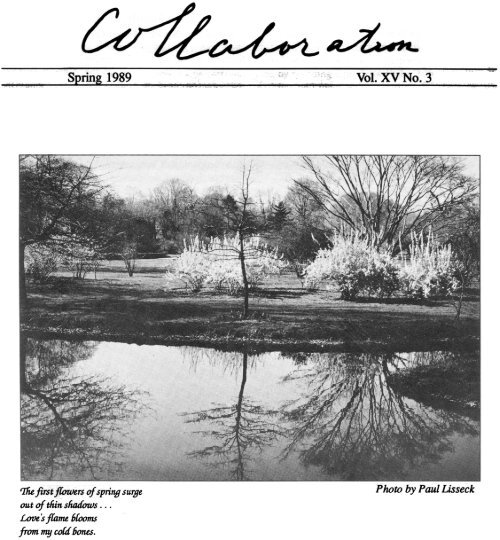
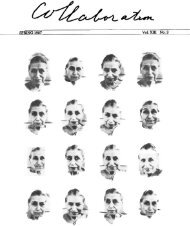
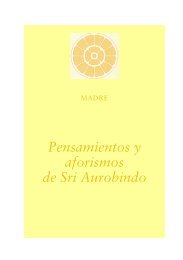
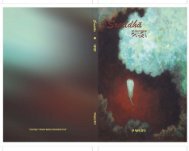
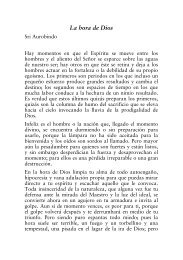

![Plegarias y meditaciones [fragmento].pdf - Sri Aurobindo Ashram](https://img.yumpu.com/30986759/1/184x260/plegarias-y-meditaciones-fragmentopdf-sri-aurobindo-ashram.jpg?quality=85)
